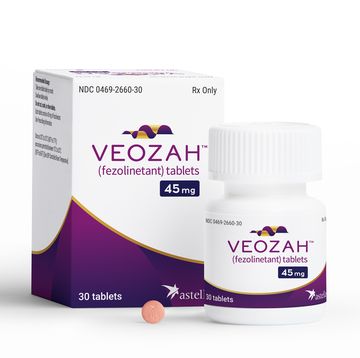An estimated 10 million people age 50 and older in the U.S. currently have osteoporosis, most of them women. Because of the bone disease’s link to declining estrogen, women who have entered menopause are most at risk.
Osteoporosis is characterized by low bone mass that leads to an increased risk of fracture of the hip, wrist, or spine. It’s said to be the most common disease in humans, and it can actually shorten people's lifespan.
Meet the experts: Mary Jane Minkin, M.D., a clinical professor in the department of obstetrics, gynecology, and reproductive sciences at Yale Medical School in New Haven, Connecticut; and Joseph Lane, M.D., a professor of orthopedic surgery and chief of the Metabolic Bone Disease Service at the Hospital for Special Surgery/Weill Cornell Medical College, in New York City.
And just over 43 million Americans are at risk of osteopenia, low bone mass, which also can lead to fractures and ultimately develop into osteoporosis.
We consulted two in-the-know doctors to lay out the myths and realities of these conditions and the drugs used to treat them.
1. You may not know if you have osteopenia or osteoporosis.
These conditions are silent. Your first indication of either may be a fracture or the loss of more than two inches in height(!). But there are many known risks, including being on high doses of steroids, having an eating disorder like anorexia, and weighing less than 127 pounds. A family history of the conditions, fair skin, and poor nutrition—especially a lack of dairy foods high in calcium—are also risk factors, as are cigarette smoking and high alcohol consumption.
2. Drugs can stop or reverse the problem...
There’s a class of drugs called bisphosphonates that are prescribed to treat low bone density, which includes alendronic acid, ibandronic acid, risedronic acid, romosozumab, and zoledronic acid. They prevent bone loss by inactivating the osteoclast, a type of bone cell that reabsorbs bone tissue, or by preventing its formation. Other medications, like teriparatide, promote bone growth.
However, the FDA has issued frequent warnings about these drugs, including that they can lead to bone, joint, and/or muscle pain; esophageal erosions; heartburn; arrhythmias; or rapid heartbeat. “You’re balancing the risks and benefits,” says Mary Jane Minkin, M.D., a clinical professor in the department of obstetrics, gynecology, and reproductive sciences at Yale Medical School in New Haven, Connecticut. “Oral bisphosphonates also carry a very slight risk of jaw problems, and some fractures. But they’re very rare.”
3. ...but there’s a time limit on taking them.
“Most of these drugs are only safe within the window of study by the FDA, and that is usually three years,” says Joseph Lane, M.D., a professor of orthopedic surgery and chief of the Metabolic Bone Disease Service at the Hospital for Special Surgery/Weill Cornell Medical College, in New York City. “Beyond that point, the skeleton is altered and adverse events can occur, such as femoral fractures and osteonecrosis of the jaw—weakening, and ultimately death, of the jawbone. Patients who have been taking these drugs should be carefully reviewed after three to five years, and a new decision made as to whether they should be continued, stopped, or changed.” Doctors also commonly have patients take a “drug holiday” if they’ve been on these meds for a while.
4. If you have osteopenia you probably don't need medication.
Patients diagnosed with osteopenia and not osteoporosis are rarely prescribed drugs (with the exception of those with breast cancer who are on aromatase inhibitors for therapy, who are therefore at higher risk for bone loss). “In general, when I diagnose osteopenia in my patients, we sit down and have a good talk,” says Dr. Minkin. “If she’s smoking, can she stop or at least cut down? Is she getting calcium-rich foods? Is she taking her vitamin D? Is she doing weight-bearing exercises regularly? I’m a big nut on strength training; I encourage all my patients to go to the gym and exercise.”
5. Think area rugs, thyroid, and everything in between.
Good diet, exercise, adequate calcium intake, normal vitamin D levels, and taking precautions at home so you don’t fall are all important. “Good habits around the house help,” says Dr. Minkin. “Don’t set yourself up for fractures: Keep throw rugs out of the way, wear sensible shoes, and so on.” Parathyroid and thyroid hormone levels can also impact bone health. “Hyperparathyroidism is amazingly common, and the surgery to remove the overactive gland is usually quite successful,” she says. “I recently received a letter from a patient who had her overactive parathyroid removed a few months ago—she hasn’t felt this good in ages, because her calcium had been high, and that can make you feel crummy. There is a lot of management other than medications.”
6. Having low bone density doesn’t mean you’re destined for fractures.
While a decrease in bone density does correlate with fracture risk, Lane contends that it only accounts for 20% to 60% of the risk. “There are many factors that contribute, and you don’t have to have osteoporosis to fracture a bone,” adds Dr. Minkin.
7. Osteoporosis drugs can actually make bones more brittle and breakable.
“Improving bone density lowers risk, but does not totally prevent fractures,” says Lane. “And prolonged use of osteoporosis drugs is associated with loss of bone toughness and brittleness in some people. Still, these drugs help more patients than they hurt.”
A conversation with your doctor can help you identify what is right for you and your bone-health situation.













